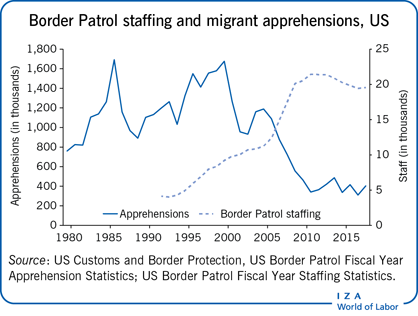Elevator pitch
Border enforcement of immigration laws raises the costs of illegal immigration, while interior enforcement also lowers its benefits. Used together, border and interior enforcement therefore reduce the net benefits of illegal immigration and should lower the probability that an individual will decide to illegally migrate. While empirical studies find that border and interior enforcement serve as deterrents to illegal immigration, immigration enforcement is costly and carries unintended consequences, such as a decrease in circular migration, an increase in smuggling, and higher prevalence of off-the-books employment and use of fraudulent and falsified documents.

Key findings
Pros
Border enforcement works as intended: it drives up the cost and risks associated with border crossings and deters illegal immigration.
Border enforcement results in more positively selected migrant flows, possibly due to the higher costs of crossing.
Interior enforcement lowers the benefits of migration, which should act as a deterrent.
While the cost of enforcement is a burden on taxpayers, native workers may benefit when there is less competition from migrants entering, at least in the short term.
The unintended consequences of border and interior enforcement are reduced when accompanied by other immigration reforms, such as a regularization program or a temporary worker program.
Cons
Intensified border enforcement leads to reduced circular migration, higher demand for smugglers, riskier crossings, and more migrant deaths.
Relying on border enforcement alone to keep migrants out causes wages to rise in the destination country and fall in the source country, counteracting the higher crossing costs and increasing incentives to migrate.
Interior enforcement, such as employer verification mandates, lower employment and wages among unauthorized immigrants and can result in worse outcomes for their minor children.
Additional interior enforcement can increase informal sector employment, where workers and employers evade taxation and regulation.
Immigration enforcement is costly and can divert resources from other federal and state law enforcement priorities.